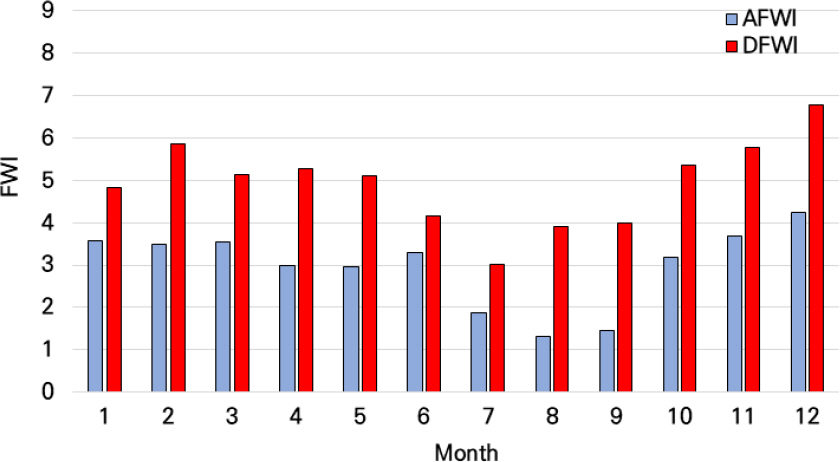1. Flannigan, M.D, Krawchuk, M.A, de Groot, W.J, Wotton, B.M, and Gowman, L.M (2009) Implications of changing climate for global wildland fire.
International Journal of Wildland Fire, Vol. 18, No. 5, pp. 483-507.

2. Gouveia, C.M, Bastos, A, Trigo, R.M, and DaCamara, C.C (2012) Drought impacts on vegetation in the pre-and post-fire events over Iberian Peninsula.
Natural Hazards and Earth System Sciences, Vol. 12, No. 12, pp. 3123-3137.

3. Groot, W.J.D, Field, R.D, Brady, M.A, Roswintiarti, O, and Mohamad, M (2007) Development of the Indonesian and Malaysian fire danger rating systems.
Mitigation and Adaptation Strategies for Global Change, Vol. 12, pp. 165-180.


4. Jeong, J.Y, Woo, S.H, Son, R.H, Yoon, J.H, Jeong, J.H, Lee, S.J, et al (2018) Spring forest-fire variability over korea associated with large-scale climate factors. Atmopshere Korean Meteorological Society, Vol. 28, No. 4, pp. 457-467.
5. Kang, Y, Park, S, Jang, E, Im, J, Kwon, C.G, and Lee, S (2019) Spatio-temporal enhancement of forest fire risk index using weather forecast and satellite data in South Korea. Journal of the Korean Association of Geographic Information Studies, Vol. 22, No. 4, pp. 116-130.
6. Korea Forest Service (KFS) (2023) Statistical yearbook of wildfires 2022. Korea Forest Service.
7. Kwak, J, Kim, S, Kim, G, Singh, V.P, Park, J, and Kim, H.S (2016) Bivariate drought analysis using streamflow reconstruction with tree ring indices in the Sacramento Basin, California, USA.
Water, Vol. 8, No. 4, pp. 122.

8. Littell, J.S, Peterson, D.L, Riley, K.L, Liu, Y, and Luce, C.H (2016) A review of the relationships between drought and forest fire in the United States.
Global Change Biology, Vol. 22, No. 7, pp. 2353-2369.



9. Masinda, M.M, Li, F, Qi, L, Sun, L, and Hu, T (2022) Forest fire risk estimation in a typical temperate forest in Northeastern China using the Canadian fire weather index:Case study in autumn 2019 and 2020.
Natural Hazards, Vol. 111, pp. 1085-1101.

10. McArthur, A.G (1966) Weather and grassland fire behaviour. Commonwealth of Australia, Forestry and Timber Bureau, Leaflet 100, Camberra, Australia.
11. Ministry of Environment (2022) Guidelines for the development of drought vulnerability map. Ministry of Environment.
12. Park, H.S, Lee, S.Y, Chae, H.M, and Lee, W.K (2009) A study on the development of forest fire occurrence probability model using canadian forest fire weather index–Occurrence of forest fire in kwangwon province-. J. Korean Soc. Hazard Mitig, Vol. 9, No. 3, pp. 95-100.
13. Park, S, Lee, S.W, Kim, T, and Choi, J (2020) Analysis of seasonal effects between drought intensity and the frequency of forest fires.
The Geographical Journal of Korea, Vol. 54, No. 3, pp. 299-309.

14. Pereira, P, Úbeda, X, and Martin, D.A (2012) Fire severity effects on ash chemical composition and water- extractable elements.
Geoderma, Vol. 191, pp. 105-114.

15. Pokharel, B, Sharma, S, Stuivenvolt-Allen, J, Wang, S.Y.S, LaPlante, M, Gillies, R.R, et al (2023) Amplified drought trends in Nepal increase the potential for Himalayan wildfires.
Climate Change, Vol. 176, Article Number 17.


16. Reinhard, M, Rebetez, M, and Schlaepfer, R (2005) Recent climate change:Rethinking drought in the context of forest fire research in Ticino, South of Switzerland.
Theoretical and Applied Climatology, Vol. 82, pp. 17-25.


17. Richardson, D, Black, A.S, Irving, D, Matear, R.J, Monselesan, D.P, Risbey, J.S, et al (2022) Global increase in wildfire potential from compound fire weather and drought.
NPJ Climate and Atmosphere Science, Vol. 5, No. 1, Article Number 23.


18. Ruffault, J, Curt, T, Martin-StPaul, N.K, Moron, V, and Trigo, R.M (2018) Extreme wildfire events are linked to global-change-type droughts in the northern Mediterranean.
Natural Hazards and Earth System Sciences, Vol. 18, No. 3, pp. 847-856.

19. Shiau, J.T, and Shen, H.W (2001) Recurrence analysis of hydrologic droughts of differing severity.
Journal of Water Resources Planning and Management, Vol. 127, No. 1, pp. 30-40.

20. Stocks, B.J, Lawson, B.D, Alexander, M.E, Wagner, C.V, McAlpine, R.S, Lynham, T.J, et al (1989) The Canadian forest fire danger rating system:An overview.
The Foresty Chronicle, Vol. 65, No. 6, pp. 450-457.

21. Turco, M, von Hardenberg, J, AghaKouchak, A, Liasat, M.C, Provenzale, A, and Trigo, R.M (2017) On the key role of droughts in the dynamics of summer fires in Mediterranean Europe.
Scientific Reports, Vol. 7, No. 1, Article Number 81.


22. Turner, M.G, Hargrove, W.W, Gardner, R.H, and Romme, W.H (1994) Effects of fire on landscape heteorogeneity in Yellowstone National Park, Wyoming. Journal of Vegetation Science, Vol. 5, No. 5, pp. 731-742.
23. UNISDR (2009). Drought risk reduction framework and practices:Contributing to the implementation of the Hyogo framework for action. United nations secretariat of the international strategy for disaster reduction, UNISDR, Geneva, Switzerland.
24. Van Wagner, C.E (1987). Development and structure of the Canadian Forest Fire Weather Index System. Canadian Forestry Service, Headquarters, Ottawa.
25. Vitolo, C, Di Giuseppe, F, Krzeminski, B, and San-Miguel- Ayanz, J (2019) A 1980-2018 global fire danger re-analysis dataset for the Canadian fire weather indices.
Scientific Data, Vol. 6, No. 1, pp. 1-10.




26. Xiao, J, and Zhuang, Q (2007) Drought effects on large fire activity in Canadian and Alaskan forests.
Environmental Research Letters, Vol. 2, No. 2, pp. 044003.

27. Yoo, J, Han, J, Kim, D, and Kim, T.W (2021) Evaluating impact factors of forest fire occurrences in Gangwon province using PLS-SEM:A focus on drought and meteorological factors. Journal of Civil and Environmental Engineering Research, Vol. 41, No. 3, pp. 209-217.
28. Yoon, S.H, and Won, M.S (2016) Correlation analysis of forest fire occurrences by change of standardized precipitation index.
Journal of the Korean Association of Geographic Information Studies, Vol. 19, No. 2, pp. 14-26.



















